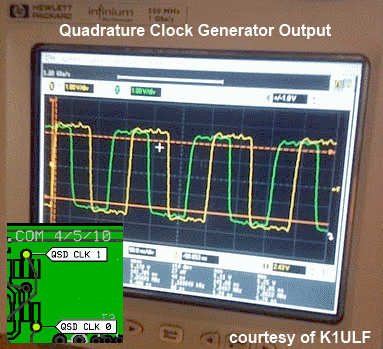Quadrature Clock Generator Introduction
General
This stage divides the local oscillator output by 4 and shifts the phase of the dividend signals such that they are now one-fourth the LO frequency and 90 degrees separated in phase (i.e., in quadrature). Both signals are identical in all regards except phase. They will be used to clock the switch used in the Quadrature Sampling Detector (QSD) stage.
(go directly to build notes)Quadrature Clock Generator Schematic
(Resistor testpoints (hairpin, top, or left-hand lead), as physically installed on the board, are marked in the schematic with red dots)
(Click for Full Schematic)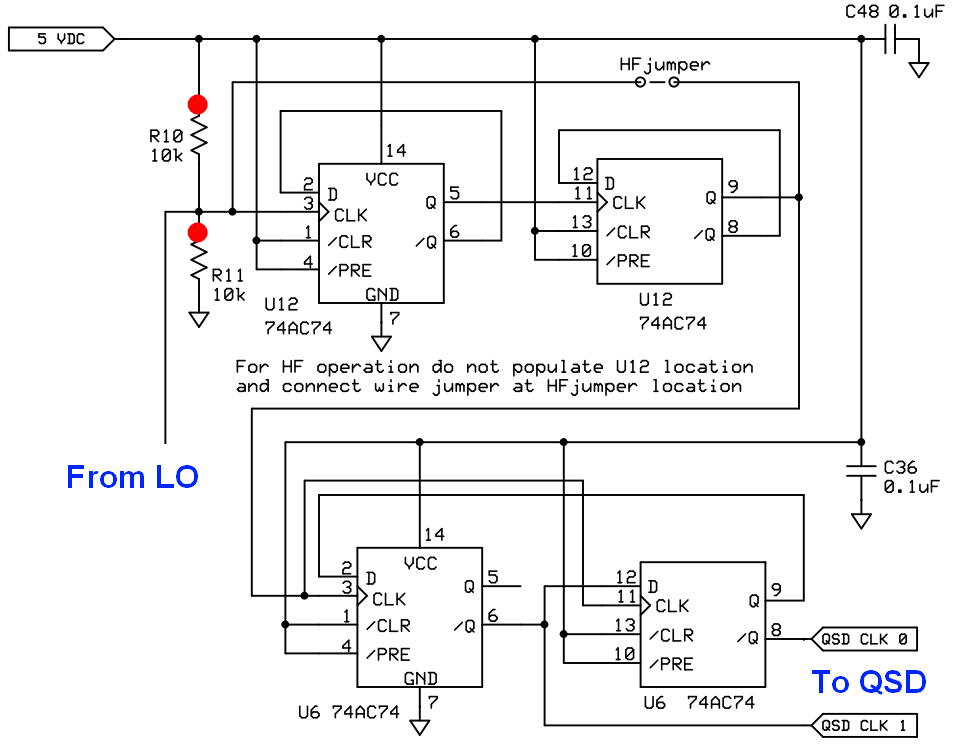
(above schematic has clickable areas that can be used for navigation)
(go directly to build notes)Quadrature Clock Generator Bill of Materials
Stage Bill of Materials
(resistor images and color codes courtesy of WIlfried, DL5SWB's R-Color Code program)
| Check | Designation | Component | Marking | Category | Orientation | Notes | Circuit |
|---|---|---|---|---|---|---|---|
| ❏ | C48 | band-specific | misc | Quadrature Clock Generator | |||
| ❏ | hf-jmp | band-specific | misc | Quadrature Clock Generator | |||
| ❏ | C36 | 0.1 uF | (smt) black stripe
 | SMT 1206 | yellow pads | Quadrature Clock Generator | |
| ❏ | R10 | 10 k 1/6W 5% | brn-blk-ora-gld
 | 1/6W | S-N | Quadrature Clock Generator | |
| ❏ | R11 | 10 k 1/6W 5% | brn-blk-ora-gld
 | 1/6W | N-S | Quadrature Clock Generator | |
| ❏ | U06 | 74AC74 Dual D FF | 74AC74
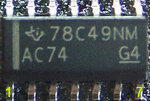 | SOIC-14 | 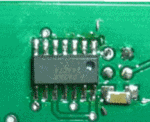 | Markings vary - look for "AC74" | Quadrature Clock Generator |
| ❏ | U12 | band-specific | misc | Quadrature Clock Generator |
Band Specific Items for HF Band
| Check | Designation | Component | Marking | Category | Orientation | Notes | Circuit |
|---|---|---|---|---|---|---|---|
| ❏ | C48 | omit for this band | Omit | Quadrature Clock Generator | |||
| ❏ | hf-jmp | shunt wire (cut-off lead) | Cutoff | Quadrature Clock Generator | |||
| ❏ | U12 | omit for this band | Omit | Quadrature Clock Generator |
Band Specific Items for LF Band
| Check | Designation | Component | Marking | Category | Orientation | Notes | Circuit |
|---|---|---|---|---|---|---|---|
| ❏ | C48 | 0.1 uF | (smt) black stripe
 | SMT 1206 | Quadrature Clock Generator | ||
| ❏ | hf-jmp | omit for this band | Omit | Quadrature Clock Generator | |||
| ❏ | U12 | 74AC74 Dual D FF | 74AC74
 | SOIC-14 | Quadrature Clock Generator |
Quadrature Clock Generator Summary Build Notes
- Install Voltage Divider Resistors
- Install ICs and SMT Capacitors
- Install HF Jumper
- Test the Stage
Quadrature Clock Generator Detailed Build Notes
Bottom of the Board

Install ICs and SMT Capacitors
Here, you will install U6 (to get a divide-by-4) and, if building the LF option, U12 (to get a divide-by-16); also installed will be the appropriate SMT bypass capacitors.
U6 is required for both HF and LF options; U12 is only needed for the LF option. Watch out for the potential to install U6 in the wrong set of pads!
| Check | Designation | Component | Marking | Category | Orientation | Notes | |||||||||
|---|---|---|---|---|---|---|---|---|---|---|---|---|---|---|---|
| ❏ | C48 | band-specific |
| misc | |||||||||||
| ❏ | C36 | 0.1 uF | (smt) black stripe
 | SMT 1206 | yellow pads | ||||||||||
| ❏ | U06 | 74AC74 Dual D FF | 74AC74
 | SOIC-14 |  | Take ESD precautions Markings vary - look for "AC74" | |||||||||
| ❏ | U12 | band-specific |
| misc |
Top of the Board
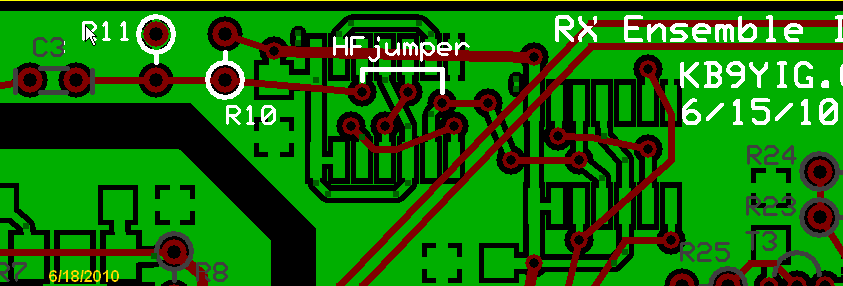
Install Voltage Divider Resistors
Pay careful attention to the orientation (S-N and N-S, respectively) of R10 and R11. Some builders have inadvertently installed these with a horizontal orientation rather than a vertical orientation.
| Check | Designation | Component | Marking | Category | Orientation | Notes |
|---|---|---|---|---|---|---|
| ❏ | R10 | 10 k 1/6W 5% | brn-blk-ora-gld
 | 1/6W | S-N | |
| ❏ | R11 | 10 k 1/6W 5% | brn-blk-ora-gld
 | 1/6W | N-S |
Install HF Jumper
If building the HF option, omit U12 and Install the jumper wire to bypass U12 with the LO signal
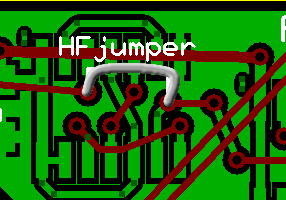
| Check | Designation | Component | Marking | Category | Orientation | Notes | |||||||||
|---|---|---|---|---|---|---|---|---|---|---|---|---|---|---|---|
| ❏ | hf-jmp | band-specific |
| misc |
Quadrature Clock Generator Completed Stage
(These photos were of an earlier board design. It has changed since the author built the kit upon which these notes are based. The board layout graphics are, however, current.)Top of the Board
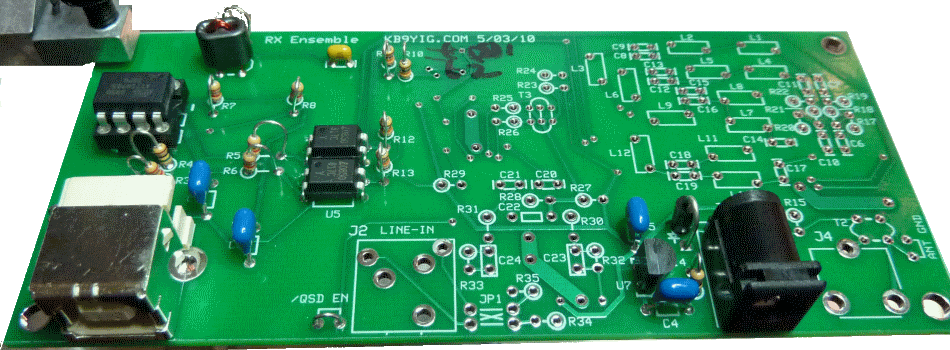
Bottom of the Board
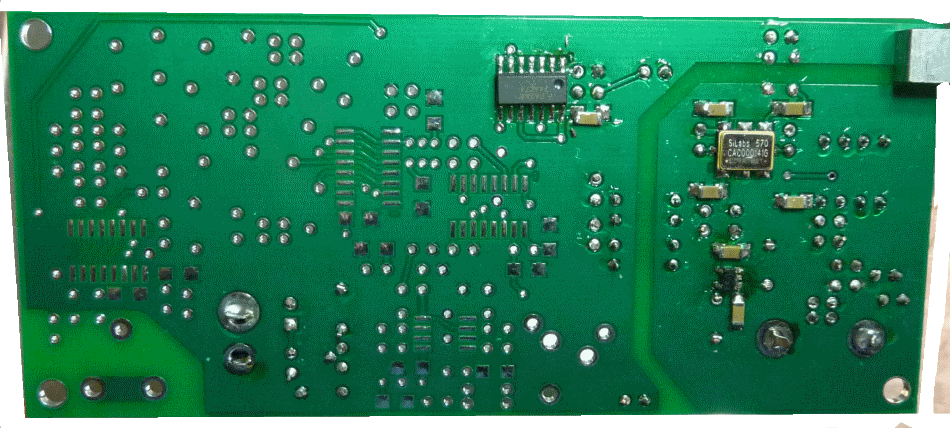
Quadrature Clock Generator Testing
Current Draw
Test Setup
With both the USB cable and the power cable plugged in, measure the current draw in the positive power lead.
Measure the current draw with just the 12V power.
Note: the current draw will be slightly higher if you installed U12 as part of an LF option build
Test Measurements
| Testpoint | Units | Nominal Value | Author's | Yours |
|---|---|---|---|---|
| Current draw WITH USB | mA | < 18 | 9.8 | _______ |
| Current draw NO USB | mA | < 20 | 13.7 | _______ |
Test Voltage Divider
Test Setup
When performing the following tests, you must apply [pwer to the board AND plug in the USB cable. Otherwise, results will not be as expected.
Plug in USB and power the board.
Measure the voltage on the R11 hairpin; you should see 50% of the %v rail voltage.
Depending upon your DMM, your measurements may vary. What we are looking for here is roughly half the 5 volt rail
Test Measurements
| Testpoint | Units | Nominal Value | Author's | Yours |
|---|---|---|---|---|
| R11 hairpin (WRT regular gnd) | V dc | 2.5 | 2.46 | _______ |
Divider Pin Voltages
Test Setup
Power USB and 12V. Then measure the voltages on the pins (and, separately, on the pads) of U6 (74AC74). Refer to the color codes on the graphic for the voltages.
Pins 3 and 11 will not show exactly 2.5Vdc because they have the additional AC component of the local oscillator signal from C3. The important idea is - for those pins which should nominally be 2.5Vdc - you do NOT want to see 0 or 5 Vdc!
If you are building the LF option, you should perform this test on both U12 and U6; otherwise, just test U6.
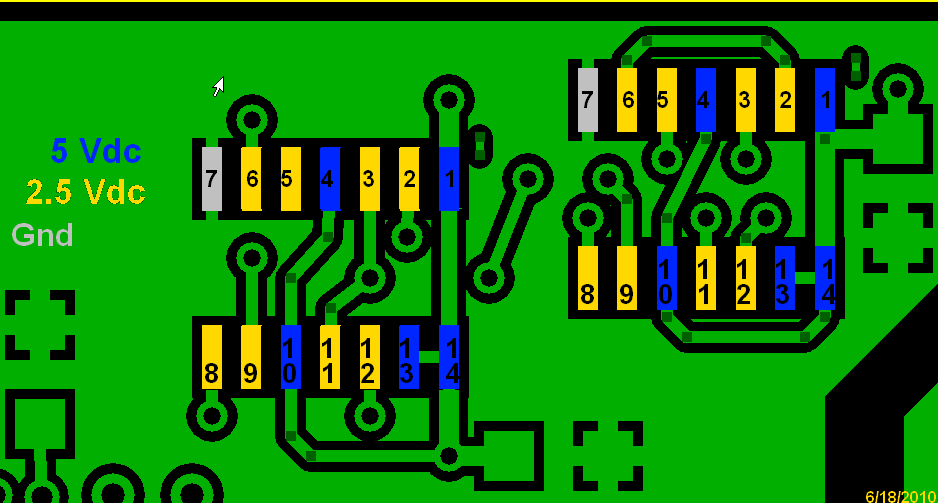
Test Measurements
| Testpoint | Units | Nominal Value | Author's | Yours |
|---|---|---|---|---|
| Pin 1 | Vdc | 5 | 4.92 | _______ |
| Pin 2 | Vdc | 2.5 | 2.45 | _______ |
| Pin 3 | Vdc | 2 to 3 | 2.46 | _______ |
| Pin 4 | Vdc | 5 | 4.92 | _______ |
| Pin 5 | Vdc | 2.5 | 2.45 | _______ |
| Pin 6 | Vdc | 2.5 | 2.45 | _______ |
| Pin 7 | Vdc | 0 (GND) | 0 | _______ |
| Pin 8 | Vdc | 2.5 | 2.45 | _______ |
| Pin 9 | Vdc | 2.5 | 2.45 | _______ |
| Pin 10 | Vdc | 5 | 4.92 | _______ |
| Pin 11 | Vdc | 2.5 | 2.46 | _______ |
| Pin 12 | Vdc | 2 - 3 | 2.45 | _______ |
| Pin 13 | Vdc | 5 | 4.92 | _______ |
| Pin 14 | Vdc | 5 | 4.92 | _______ |
Quadrature Colck Generated Waveforms
Test Setup
Set your board up to oscillate at a selected center frequency, e.g., 7.100 MHz.
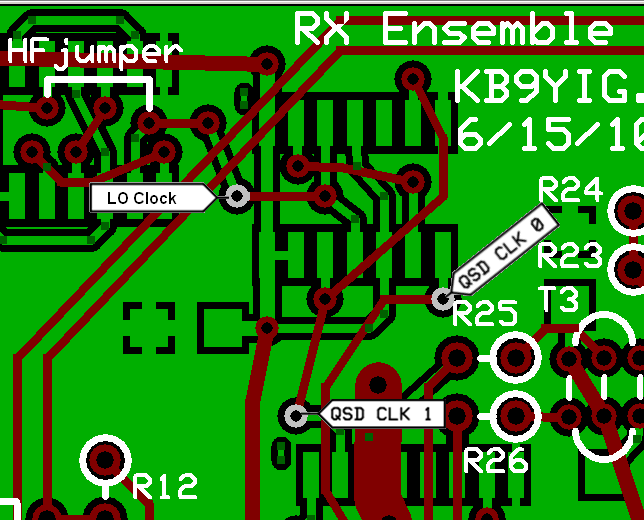
If you have a dual trace scope available, probe the two "QSD CLK (n)" test points and you should get a waveform similar to the one shown here.
The testpoint marked "LO Clock" will provide the Si570's output frequency or, in the case of the LF option, that frequency divided by 4 (courtesy of U12).
Your mileage may vary, depending upon the desired center frequency you select and the quality of your scope (some scopes tend to have issues with these square waves - still, the scope should show two waveforms in quadrature at the desired center frequency).
